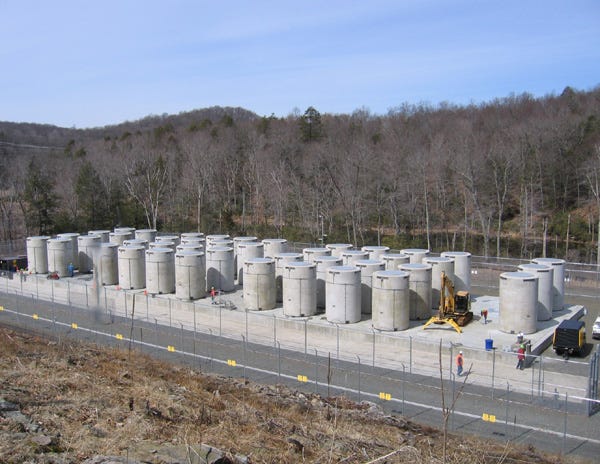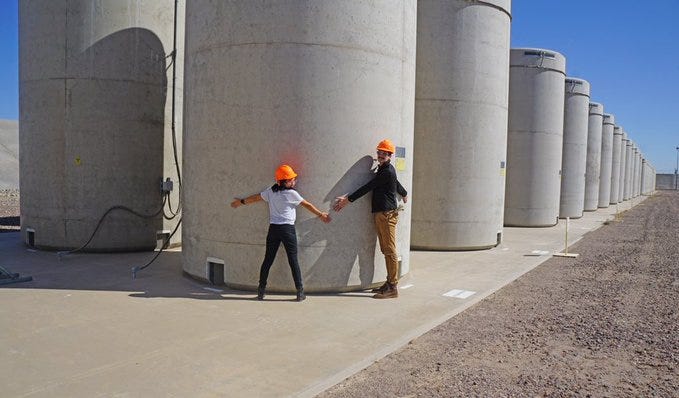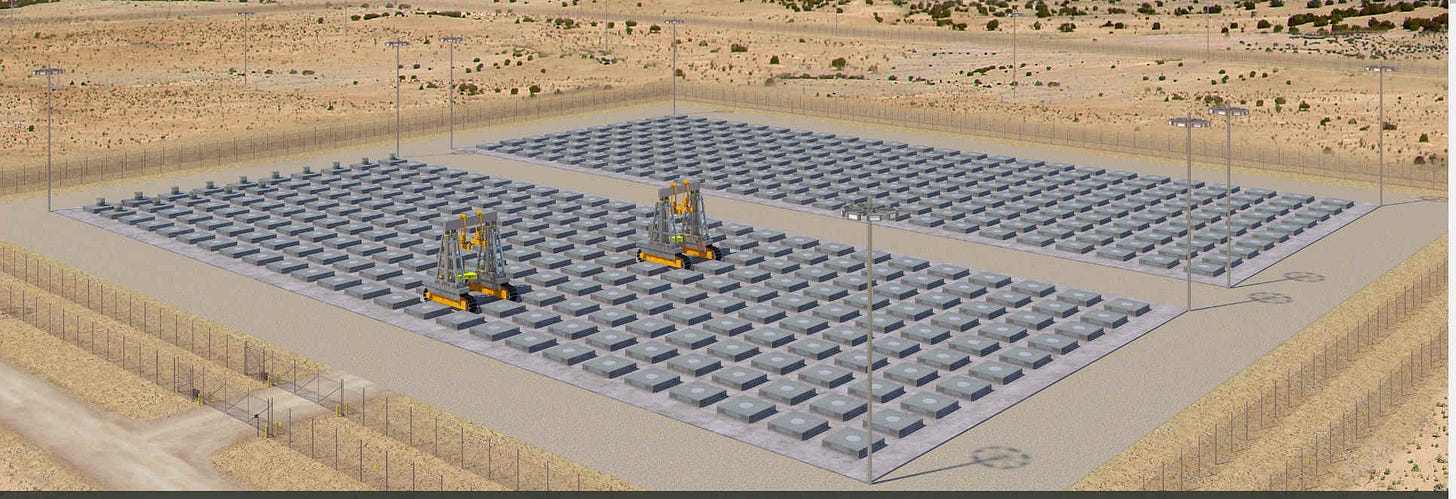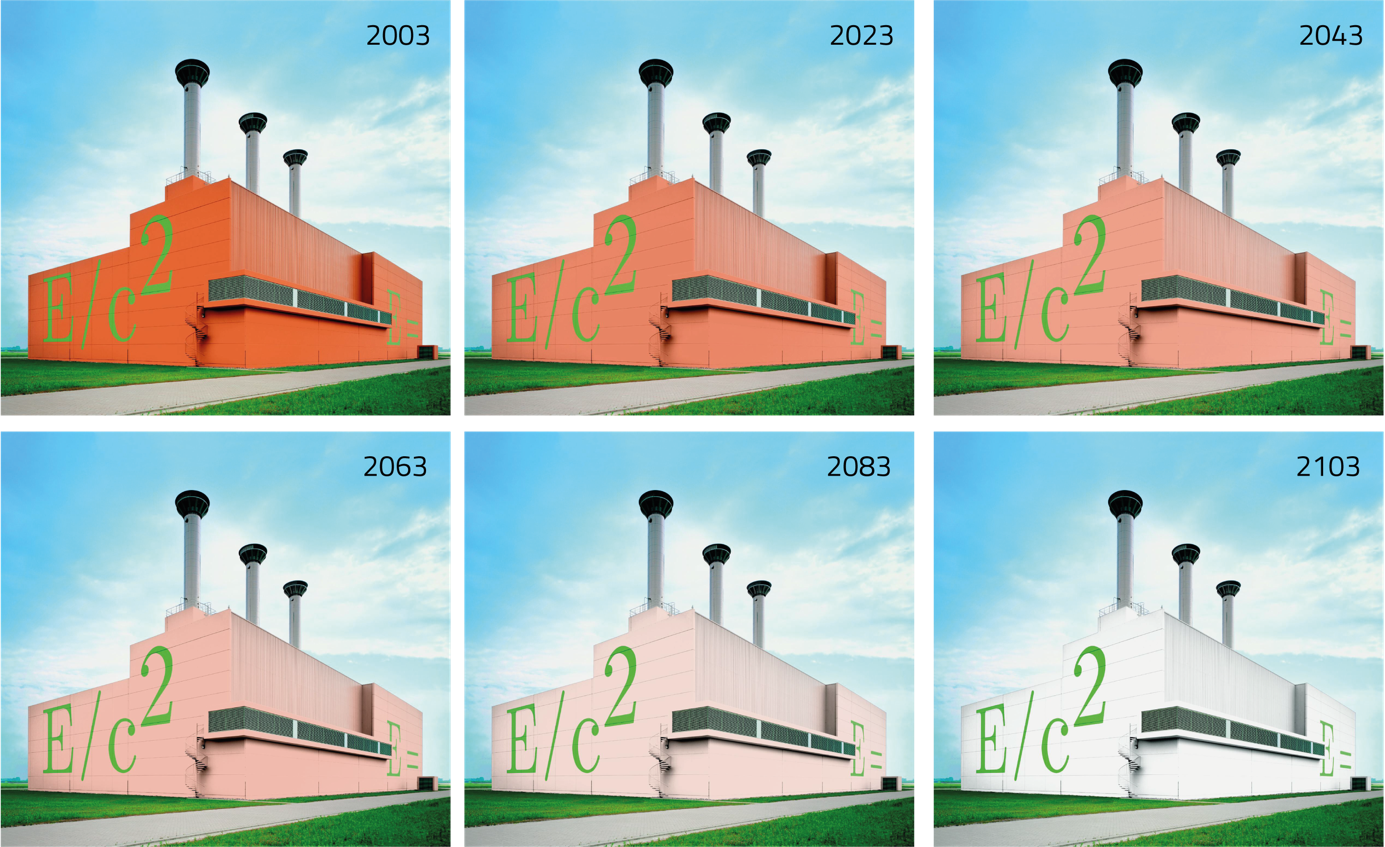I've been bemused by the response to the slide decks. People open the email multiple times, but don't view the slides??? Apparently this is standard behavior in these strange times. So I've decide to repost some of the old articles incorporating the new stuff in the slides. We start with spent nuclear fuel.
This article has a major error. Figure 12 shows submarine reactor compartments lanfilled at Hanford, not the reactor cores at Idaho National Lab. The latter are stored indoors at the Expended Core Facility. Mea culpa.
Takeaway
For practical purposes, spent nuclear fuel remains radioactive forever. However, the penetrating form of radiation is essentially gone in 600 years. After that, the spent fuel must be swallowed to be harmful. But that would require eating rocks. Bacon is probably more dangerous than aged nuclear fuel. You are much more likely to swallow that carcinogen.
Tiny quantity, three particles
Recent events have forced all sorts of people to think seriously about nuclear power, many for the first time in their lives. And often their first question is: what about the waste? What will we do with the extremely radioactive spent fuel? There are two keys to understanding the nuclear spent fuel problem:
The quantities involved.
Thanks to nuclear's insane energy density, the amount of spent fuel is so small that we can afford to handle it very carefully.
Figure 1. Lifetime High Level Waste (courtesy Nick Touran)
A 1 GW nuclear power plant requires about 27 tons of fuel per year, and produces about the same amount of high level waste. Spent fuel is dense. 27 tons occupies about 2.5 m3 or the capacity of a good sized refrigerator. The US currently gets 20% of its electricity from nuclear, which results in 2000 tons of spent fuel per year. This waste would fill three 40 foot containers. If the US produced all its electricity from nuclear, the annual used fuel would fill six railroad coal cars. No wonder David MacKay called spent fuel ``a beautifully small problem".
The particles involved.
Figure 2. Penetrating and non-penetrating radiation.
Spent nuclear fuel emits three forms of radiation: alpha particles, electrons, and photons (often called gamma rays). Alpha particles have no penetrating power. They are stopped by a piece of paper or a few centimeters of air. Electrons (confusingly called beta rays in this context) have very little penetrating power. Most are stopped by the outer layer of our skin. Alpha particles and most electrons must be swallowed to be a health hazard. They require little or no shielding.
Photons on the other hand can have enormous penetrating power. High energy photons can pass all the way through a human being. You don't want to mess with these photons. Fresh used fuel puts out a lot of high energy photons and needs lots of shielding.
Overtime, radioactive materials decay, and the radiation levels drop off. Different radioactive materials decay at very different rates. Most of the photon emitters in the used fuel decay rather rapidly. After less than 600 years, the photon dose rate at a fuel element surface is so low, that according to Department of Energy rules, it can be handled without any shielding at all. For practical purposes, the photon emitters are gone in 600 years. What's left are alpha and a small amount of electron emitters.
The electron and especially the alpha emitters tend to decay far more slowly. 95% of the used fuel is Uranium-238, an alpha emitter. The half-life of U-238 is 4.5 billion years. The alpha emitters are around essentially forever. So the rule is simple. Don't eat spent nuclear fuel, even if it's 600 years old. But you have plenty of substances around the house for which the same rule applies.
This is what we are worried about?
Currently, in the US, spent nuclear fuel is stored at each plant, mostly in dry casks. Figure 3 shows the dry cask storage facility for the Connecticut Yankee nuclear power plant near Haddam Neck on the Connecticut River.
Figure 3 Connecticut Yankee Dry Storage Facility
Connecticut Yankee (CY) was a 619 MWe pressurized water reactor which ran for 28 years between 1968 and 1996. During that time the plant produced 110 million MWh. There are 43 casks on a concrete pad, 70 feet by 228 feet. These casks contain about 1020 tons of used fuel. The fuel is surrounded by 3.5 inches of steel and then 21 inches of reinforced concrete. Each cask weighs about 126 tons, of which about 25 tons is the used fuel itself. Each cask also has internal passages for natural draft circulation to remove the heat produced by the used fuel's radioactive decay. These show up in Figure 3 as the rectangular slots at the bottom and top of each cask.
If Connecticut Yankee had been a coal plant, it would have produced between 3,000,000 and 6,000,000 tons of toxic ash in its operating life, not to mention 110 million tons of CO2. If we attempted to store this ash on the CY fuel cask pad, we would have a column of ash about 7000 feet high. The volume of solid waste per unit power produced by a nuclear power is 100,000 times less than that produced by a coal plant.
The spent fuel in these casks falls into one of three categories:
1. Uranium.
2. Plutonium and other transuranics.
3. Fission products.
Uranium
By weight, uranium represents about 96% of the spent fuel. Almost all of this is U-238. This means the fuel is potentially quite valuable. Current nuclear's energy density is 500,000 times higher than fossil fuels, 12,500,000,000 times higher than hydro, and 250,000,000,000 times higher than wind, when the wind is blowing. That sounds pretty good. But it could be a lot better. Today's nuclear technology is woefully inefficient in its use of potentially fissile material. More than 97% of the energy that could theoretically be generated from the fuel is still in the fuel when it is pulled from the reactor, Figure 4.
Figure 4. Composition of Spent Fuel}
Transuranics
Some of the neutrons bouncing around in the reactor do not result in fission, but are absorbed by the fuel, transmuting the uranium into still heavier elements, mostly plutonium. This group is known as the transuranics (TRU). By weight the TRU represent about 1% of the used fuel. Transuranics decay by emitting alpha particles and some electrons. Neither have any real penetrating power. Few can penetrate the outer layer of skin. In order for alpha particles or electrons to be a problem, they must be ingested or inhaled. Being a bit rhetorical here. To be precise, the alpha and electron emitters must be swallowed for the particles to be harmful.
Transuranic decay tends to be very slow with some important transuranic isotopes having half-lives of the order of millions of years. Transuranics also can be quite valuable. Some such as Plutonium-238 can be used to power deep space probes. Others can be processed into excellent nuclear fuel, although currently this is not quite economic, in part because the fission product decay makes handling the used fuel so difficult.
Fission Products
Fission products are the result of the nuclear fuel splitting into two pieces. They represent about 3% of the spent fuel. Most fission products decay by emitting photons and electrons. It is the photons that makes used fuel difficult to handle. A high energy photon can penetrate deep into a human body. Photons are the reason the casks in Figure 3 are as big as they are. They provide the shielding that allows essentially unlimited access to the storage facility.1 Cask hugging, Figure 5, is unlikely to become a national sport. But with a tiny extra bit of money, the casks could be turned into climbing walls or the pad turned into a paint ball court.
Figure 5. Cask Hugging at Palo Verdes. Credit: Paris-Ortiz-Wines
Penetrating Radiation Decay
Figure 6. Dose Rate at Fuel Element Surface, based on reference \cite{nwmo-2012}[Figure 5-13]
Figure 6 puts some numbers on the decay process. Dose is the amount of radiation energy absorbed by our tissue. Dose is measured in joules per kg of tissue. Gray is a shorthand name for joules per kg. The graph is in milligrays per day (mGy/d). The key feature of Figure 6 is that photon decay is relatively rapid, if your idea of rapid is a century of so. By year 600, 99.999% of all the photon emitters are gone, relative to the end of year 1.\cite{cohen-1977}[p 27] In fact, the photon dose rate is so low that, according to US Department of Energy rules, the used fuel elements can be contact handled, handled without any shielding at all. After year 600, the spent nuclear fuel must be swallowed in order to do any damage.2
But for how long?
It's all very well to talk about dry cask storage; but there's got to be an end to it. How long do we have to keep the stuff around?
To answer that question, I need to draw your attention to a looming problem. Currently we have roughly 6.1 million tons of reasonably assured uranium reserves. If the planet were to be totally powered by nuclear using conventional reactors, these current reserves would last 5.7 years. While more uranium will be found, clearly this is not sustainable.
Fortunately, a solution exists: breeder reactors. Breeder reactors are not new. They go back to the dawn of the nuclear age. The Russians have had a 600 MW breeder operating since 1980 and an 800 MW breeder since 2016. China and India have active breeder programs. A breeder reactor can burn not only U-235 but also U-238. This will extend our uranium reserves by a factor of 140.3 We would have at least 800 years before we need to dip into thorium and low grade uranium ores. Breeders open up the possibility of extracting uranium from sea water. There is about 4 billion tons of uranium in the oceans, which is replenished at the rate of 32,000 tons per year from erosion.
Right now in the USA alone, there is about 90,000 tons of already refined U-238. sitting in dry cask storage around the country. The stupidest thing we could do is put this fuel where we cannot get it. Of course, that's precisely what we are planning to do, in the form of deep geologic repositories.
Rather than this criminal idiocy, the obvious solution to the nuclear waste problem is:
1. Keep the material in dry cask storage until the photon emitters have largely decayed away.
If the US were to generate all its electricity from nuclear, a 600 year decay time means she would have to devote at most 21 square miles --- about the size of Manhattan --- to dry cask storage. More to the point, this area is one-tenth the size of a single solar facility, the Riverside East Solar Zone in the Mojave. This area is based on the Histore system, Figure 8, which needs one acre to store 580 tons of used fuel.
Figure 8. Histore Pad. 580 tons of used fuel per acre
More compact solutions exist. A vault can be more compact than dry casks since there is no need to shield each canister separately. Figures 9 and 10 show the Dutch HABOG spent fuel vault. Every 20 years the building is repainted a lighter color, an unsubtle reminder that the photon emitters are fading away. The vault is open to the public. Even has some photo-montages in which the colors fade away. The design life is 300 years.
Figure 9. Dutch HABOG Spent Nuclear Fuel Vault
Figure 10. HABOG Interior. Note crane for emplacing and retrieving the fuel.
2. Extract the valuable medical and industrial isotopes.
3. Separate the remaining uranium and transuranics and burn them as fuel in breeders.
This will reduce the waste volume by about a factor of 10. Far more importantly, it will extend our uranium reserves by a factor of 140
4. Class C Landfill the rest.
The remaining material will be low level waste, pretty innocuous. It can be landfilled. The landfills would be located in stable, dry geology. The waste would be cemented in drums, using phosphate sand. The drums would be covered with 5 meters of earth. Uranium and TRU phosphates have very low solubility in water. The drums will eventually corrode; but even then the alpha emitters will go nowhere. Swallowing this concrete will require an immense amount of effort and ingenuity.
Figure 11. Class C Waste Cemented in Drums
Figure 12. Decommissioned submarine reactor cores at Idaho National Laboratory. These are reactor compartments after the cores have been removed, not the cores themselves.
Once we recognize the difference between penetrating and non-penetrating radiation, 600 year old nuclear fuel becomes just another poison.
Why wait 600 years?
Because the material is so valuable, it will almost certainly pay to do the extraction well before all the photon emitters have decayed away. The 75 year old spent fuel from the Hanford reactors already qualifies as Class C (landfillable) waste under NRC rules except for non-penetrating alpha emitters. If the material were diluted by a factor of four, it would fully qualify.
Despite this the nuclear establishment intends to spend 300 to 600 billion dollars of our taxpayer money on further ``clean up" of Hanford. Clean up just moves dirt around. It does not change the radioactivity one bit. This massive scam requires that the public be petrified of low dose rate radiation.
Deep Geologic Disposal is Trebly Stupid
Figure 13. The Finnish Onkalo Deep Repository
The nuclear power establishment's knee jerk solution is deep geologic disposal. Even then the material is a lurking, barely contained danger, requiring careful, multi-million dollar studies of the hazard, studies which in the end cannot even agree on which isotopes we should worry about.\cite{flop}[Appendix C]
1). Mined repositories are non-starters economically. The Finnish Onkalo repository is being pushed as a success story. But Onkalo's initial cost is somewhere north of 3.5 billion dollars. And before disposal, the fuel needs to cool for 40 to 60 years.4 So the Finns also need to pay for a generation or more of dry cask storage.
The intention is to make the spent fuel as inaccessible as possible. This is equivalent to throwing diamonds down a volcano.
Much worse, expensive geologic repositories send exactly the wrong message to the public and send it very clearly. In doing so, they inspire some of the most pretentious prose since the Victorian Age. Here's a sample.
Onkalo is constructed with the desire that its contents never be retrieved. It is a place that confronts us with timescales that scorn our usual measures. Radiological time is not equivalent to eternity, but it does function across temporal spans of such breadth that our conventional modes of imagination and communication collapse in consideration of them. Decades and centuries feel pettily brief, language seems irrelevant compared to the deep time stone-space of Onkalo and what it will hold. The half-life of uranium-235 [sic] is 4.46 billion years: such chronology decenters the human, crushing the first person to an irrelevance.\cite{macfarlane-2019}[Ch 12]
None of the decentering uranium at Onkalo was created by man. We just dug this rock up, and now it's being undug. And the four billion year half-life of U-238 means that it is a innocuous material. But by being buried in such an ostentatiously expensive manner, this lowly dirt is elevated to a supernatural level in the same way the pyramids proclaim to one and all that these few, miserable bones are the relics of a god. (Two can play the pretentious game.)
To claim that spent fuel is a potentially valuable, easily handled, moderately toxic material and then spend billions of dollars to put it 100's of meters underground is completely contradictory. The public is not fooled. If the material is as claimed, nobody would be stupid enough to waste my money that way. These people must be liars. This is extremely dangerous stuff. How can we possibly be sure a little of it won't leak back to the surface over thousands of year?5 Should I trust their claims that the repository is safe? The answer is obvious.
Why would the nuclear establishment insist on such an obviously counter-productive ``solution"? That's an easy one. For taxpayer money extraction purposes, convincing the public aged spent fuel is uniquely dangerous is not a bug. It's the goal.
The casks also protect against neutrons, a fourth particle emitted from the fuel. Neutrons are penetrating. However, the neutron dose rate is much smaller than the photon and falls off much more quickly.
The swallower's main problem would be uranium's chemical toxicity. Only 1% of the fuel is plutonium, and 99.997% of the plutonium will be excreted in a day or two. About 20% of the uranium will be absorbed into the blood and about 70% of that will end up in the kidneys. Kathren and Burklin estimate that ingesting 5 grams of uranium over a short period will result in a 50\% chance of death due to kidney failure.\cite{kathren-2008}. Others put this number as low as 0.15 grams. Cohen calculated that it would take 225 grams of 600 year old fuel to give you a 50% chance of fatal cancer from the radiation.\cite{cohen-1977}[p 31]
A good conventional reactor can generate 5.2 terajoules from a kilogram of 3.8% enriched uranium. It takes 9.5 kg of mined uranium to produce that enrichment. A breeder can produce 78 terajoules from a kilogram of mined uranium.
One of the lesser problems with deep geologic disposal is that it moves the spent fuel from a place where it is easy to cool to a place where it can't be cooled.
Or maybe a drill crew drills into the repository and pulls the perilous toxin back to the surface. You can always concoct a screw up that defeats your barriers.



















GREAT explanation of the back end of the nuclear energy fuel cycle. Nuclear waste is not a technical problem. It’s a social issue created by antinuclear fanatics that weaponized fear of it, and political career politicians that capitalized on that fear as an issue to get elected or re-elected on. I agree with the author that used nuclear fuel is valuable and I think will soon be economically recycled. But the social contract with US citizens was that Congress would provide a repository and failed too. That failure (also orchestrated by antinuclear fanatics) should have backed up the used fuel rods in cooling pools and ended nuclear energy as the antinuclear fanatics intended. When the room in cooling pools ran out, at that time, we would have had to shut the plants down. But necessity is the mother of invention. A company called Holtec came up with a dry cask storage system that can store that fuel for years. If we do build a repository the casks should be retrievable for at least 100 years. There is so much energy left in those casks we could power the US for over 1,000 years by burning it in advanced reactors. All of our nuclear waste will soon be looked at as a national treasure. So maybe the silver lining is we did not bury in a place we could not retrieve it.
Excellent! Very clear and easy to follow. I still have a couple questions, but need to take some time and read the whole piece again to see if I missed anything.